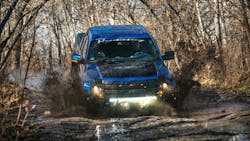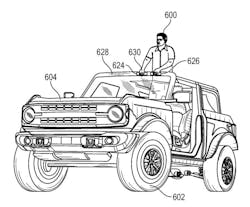Ford Innovation Would Allow Driving Off-Road While Standing
What you'll learn:
- Why would a driver need to stand up in off-road conditions?
- Creating a driver-detection system.
- Details of Ford's "stand-up" patent innovation.
To boost off-road performance, it’s essential to continually update and design vehicles with visibility in mind. The U.S. Patent and Trademark Office (USPTO) recently granted a patent to Ford Global Technologies LLC that would allow a driver to stand up in their convertible off-roader and drive it using a secondary set of controls. The patent (US 11,691,511 B2 “REDUNDANT VEHICLE CONTROLS BASED ON USER PRESENCE AND POSITION”) application was filed April 12, 2021 and granted July 4, 2023.
According to the patent, there exist special use cases in off-road driving where the driver needs to obtain a better view. Terrain and/or certain maneuvers may require the driver to be in a position other than fully seated to maintain the safety of both the vehicle and the driver. These situations may also require the driver to stand up to ensure they have the necessary visibility and vehicle clearance to safely climb over boulders, etc.
For example, when the vehicle is being driven over boulders, the driver may wish to determine if there’s sufficient clearance between the vehicle and a boulder or another object. In these positions, the driver may lose access to primary vehicle controls such as the steering wheel and/or gas and brake pedals. The secondary controls would work with sensors to control speed and torque, as well as a primary control like the steering wheel.
As the patent notes, “These non-fully seated positions may allow a driver to visualize their surrounding environment in ways that would be difficult or impossible if the driver were in a fully seated position. Alternative driver positions may include the driver leaning out a window or door frame of the vehicle, lifting up off the seat, kneeling on the seat, or even standing up in the vehicle.”
Sometimes vehicle doors and/or roof sections may be removed, and it may result in the driver not being detected as present. This would cause the termination and/or engagement of vehicle features that could hinder the driver's ability to operate the vehicle.
Detecting Driver Position
In Ford’s solution, determining the position of the driver is necessary to indicate when the driver isn’t in a fully seated position and the vehicle is in a non-seated drive mode. This is to ensure the driver is still in place and hasn’t fallen out when the going gets rough.
The system would then activate a secondary driving interface that can be used in combination with the primary driving interface of the vehicle (see figure below).
In its patent, Ford proposes a new driver-detection system using cameras, LiDAR, wideband radar, or proximity sensors that defines a driving zone in which the standing driver can operate. Determining the position of the driver can be as simple as detecting the driver's face using an instrument-cluster-mounted camera.
Ford describes a system in which certain driver-assist features would be shut down if the driver isn't detected in his/her seat. These include:
- Hill park assist: The vehicle brake is engaged to prevent backsliding during hill-climbing events.
- Traffic jam assist: The vehicle applies braking force and allows the vehicle to move up a given distance from the vehicle ahead of them.
- Trail control: A low-speed cruise control for trail and rock-climbing driving.
- Shift-to-park: Enables secure idling.
The aim here is to ensure that there’s a driver within the “driving zone” so that the safety and assistance features aren't unnecessarily shut down. In addition, the patent says it would limit off-road acceleration to 3 mph.
Concept Behind the Patent
Ford's patent shows a driver of a vehicle resembling a Ford Bronco standing up with his head out the top of the vehicle. Ford's idea is to build controls to make driving from this position safe and practical. In a topless vehicle like the Bronco, it would let one drive while standing.
As shown in the figure, a normal driver’s seated position (e.g., fully seated) may not provide the driver (number 600) with the most effective view of the road or terrain (602) necessary for optimal safe operation of the vehicle (604).
The patent further notes “secondary driving interface can include a first Macro Capacitive Sensor (MCS, 624) and a second MCS (626). For example, 624 can be used to increase a speed/torque of the wheels of the vehicle. 626 can be used to decrease the speed/torque of the wheels of the vehicle.”
In another example, 624 can be used to increase and/or decrease speed/torque of the wheels of the vehicle, while 626 can be used to control vehicle steering. In some instances, one large MCS can be utilized. Additionally, more than two MCSs can be used and assigned vehicle-control functions. Sensors located on surfaces on the windshield header or frame of the vehicle may only be accessible in a roof-off vehicle configuration.
The driver can interact with the sensor through the use of large gesture-based input, such as hand sweeps, across the sensor. These hand sweeps allow the driver to increase, decrease, or stop a vehicle while in the vehicle is in a special operational mode. By tying this special set of controls to specific operational modes of the vehicle, it ensures the driver may not inadvertently activate them during normal “on-road” operation.
Ford's patent suggests that the windshield header could host the secondary controls for driving while standing. Capacitive touchpads could be used to control vehicle speed, torque output, or even steering.
Though patents provide incentives to, and protection for, companies by offering them recognition for their creativity and the possibility of material reward for their inventions, being granted a patent doesn’t mean the idea will appear in a future product.

